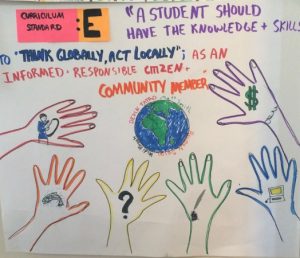The passage selected by Scott from Palmer hits a chord that we have mentioned as a class several times. In my eyes, this passage speaks to the vulnerability that we open ourselves up to as teachers. But vulnerability does not stop there. The moment a student enters into the classroom(whether the student is ours or is ourself), they/we are vulnerable to the activities of the environment. The student is open and exposed to the potential of judgement, prejudice, frustration, embarrassment, anxiety, fear, excitement, eagerness, happiness, joy, and love. The best teachers are the ones that recognize the vast array emotions and experiences that their classroom presents everyone, but they manipulate that space to be of caring and fostering so that a family is formed.
Author: Reuben Seidl
Final 680- Reflections
- How does understanding culture and power impact your teaching?
Culture is integral to the core of a person, and our students are no different. The history of education has neglected to importance of an individual’s culture, and subsequently removed some of the power that the individual felt. As educators in the current age, we are called on to provide a holistic plan pf learning for our students. Part of this plan has to take into account the importance and value of the culture that our students bring into classroom. By recognizing the cultural relevancy of our students, we can empower them to realize the importance that they bring to the world around them.
2. Pick three terms that resonate with you from the Multicultural Education word wall. Define the terms and discuss why you chose these three terms.
As a teacher, we have the power to influence our student in a myriad of ways. We can change how our students view the world, impact the lifestyle decisions they make, and adjust their perception of self. Students are influence in a variety of ways, and in some case they are not positive. In the most tragic cases, some students may not have a single positive influence in their life. It is our duty to try and be as positive an influence as positive.
As a positive influence, our students can gain a sense of empowerment. Empowerment is such an important part to a person’s self-confidence. And self-confidence is key to a person’s success.
The last word on our Culture Term Wall that spoke to me is Hope. This class has given me a huge amount of hope for the future. It has opened my eyes to issues in society that I hadn’t considered, but it has also exposed me to 40+ individuals that are all excited about creating change. And change can be a very good thing.
3. Describe your plan to teach in a culturally responsive way in the coming year. Include teaching strategies you might employ as well as content/units you will implement
Teaching in a culturally responsive way requires the employment of several tactics to get students excited about learning. One of the first tasks as a teacher is to understand the background that each student comes from. Our students will bring with them a variety of experiences, and each one is valuable in its own, unique way. Being a culturally responsive teacher requires that we acknowledge those values and experiences, and we do our best to incorporate them into the lessons.
Along with recognizing students’ previous experiences, the content of the lessons needs to be put into a context that is relatable and understandable. The context that we frame our lessons needs to be accessible for all of our students in order to insure that no one group or individual is left out of the learning opportunity. By using project-based learning, expert/elder involvement, place-based education, and cultural identity recognition, I hope to be successful in teaching in a culturally responsive way for my students.
Final Reflection- 600
PDF of Medicinal Flora Lesson Plan
 Here is my lesson plan for a traditional medicine lesson using local flora. Please feel free to use, modify, enhance, or expand at your pleasure. If you have any ideas or comments on what might make this lesson better, please share. This lesson was created with a general science and a medical intervention class in mind, but it could be easily manipulated to fit several different class settings. SOAP Note ScAK_Flora_LP
Here is my lesson plan for a traditional medicine lesson using local flora. Please feel free to use, modify, enhance, or expand at your pleasure. If you have any ideas or comments on what might make this lesson better, please share. This lesson was created with a general science and a medical intervention class in mind, but it could be easily manipulated to fit several different class settings. SOAP Note ScAK_Flora_LP
The primary Cultural Standard for Curriculum that my lesson applies to is Standard B. Standard B states that “a culturally-responsive curriculum recognizes cultural knowledge as part of a living and constantly adapting system that is grounded in the past, but continues to grow through the present and into the future.” In my lesson, students will be researching and exploring the surrounding area and identifying various native plants. From here, they would look up the traditional medicinal uses of the plants, which connects them to past knowledge of the region. This lesson can be expanded to reference present day medical research that is scouring the rainforest in search of the next best drug. The majority of modern pharmaceuticals are derived from compounds found in nature, and student’s could see the correlations between traditional medicine and present day research. The past is present, and the present leads to the future.
http://ankn.uaf.edu/publications/standards.html
Standard E
Culturally Responsive Curriculum Standard E can be summed up in the short phrase, “Think Globally, Act Locally”. The main goal of this standa rd is to have students put their local experience into a global context. By thinking globally, students may gain an appreciation for the impact that their community can have on a global scale.
rd is to have students put their local experience into a global context. By thinking globally, students may gain an appreciation for the impact that their community can have on a global scale.
One potential lesson could be for students to research the traditional hunting and fishing practices. From this point, students would look into how Fish & Game determines game management regulations and compare that to the traditional practices previously researched. I think that it would be really neat to bring in a panel of various community leaders from the game management arena to discuss how they use local insight to try to develop responsible game management practices.
Alaska’s Three Bears
 Alaska’s Three Bears by Shelley Gill tells an exciting and riveting tale of the three separate bear species found in Alaska. The story starts off with all three bears joined in a group (never happens), and they go off on a journey to find their preferred habitat. As the story progresses, the polar bear departs when they find home in the arctic, the grizzly bear finds comfort in the tundra of the interior, and the black bear traveled furthest until residing in the forests and hillsides of southern Alaska. The story is further supplemented with artistically designed footnotes and factual information at the bottom of each page.
Alaska’s Three Bears by Shelley Gill tells an exciting and riveting tale of the three separate bear species found in Alaska. The story starts off with all three bears joined in a group (never happens), and they go off on a journey to find their preferred habitat. As the story progresses, the polar bear departs when they find home in the arctic, the grizzly bear finds comfort in the tundra of the interior, and the black bear traveled furthest until residing in the forests and hillsides of southern Alaska. The story is further supplemented with artistically designed footnotes and factual information at the bottom of each page.
The artwork from illustrator, Shannon Cartwright, is where the true beauty of this book comes from. The pictures are bright, colorful, and interesting. If the story had no words, the pictures would still be able to stand on their own. The accurately depict to three bears’ specialized features, preferred habitats, and how each bear hunted and foraged for food. Overall, this would be a pretty good book to use in the classroom to introduce discussion about biological ideas regarding specialization, adaptation, yearly life cycles of bears, and the food web. This could also be used as a template for students to design their own books/stories about some other ecologically or biologically relevant topic to their community. 2.4/3 for use in the classroom.
Gill, Shelley. Alaska’s Three Bears. Homer, AK. Paws IV Publishing. 1990.
Tear Down to Build Up
The highlight of our small group discussion for me did not come until the last person shared their takeaway message. And I was very happy to hear that it was one of hope. We are going to be on the forefront of educational change, which means that there is a huge opportunity for us to make a difference within our classrooms and extend it to the communities around us. Class stratification, racial discrimination, sexuality misunderstanding, and oppression of the “others” has been imbedded into so many different facets of society that it can be difficult to totality of negative impacts that they have for all members of the community. On a more positive note, all forms of social oppression have been built or constructed by some person or group of people, and, as being constructed, they can be broken down and rebuilt into a system of equity and equality. And that gives me hope.
